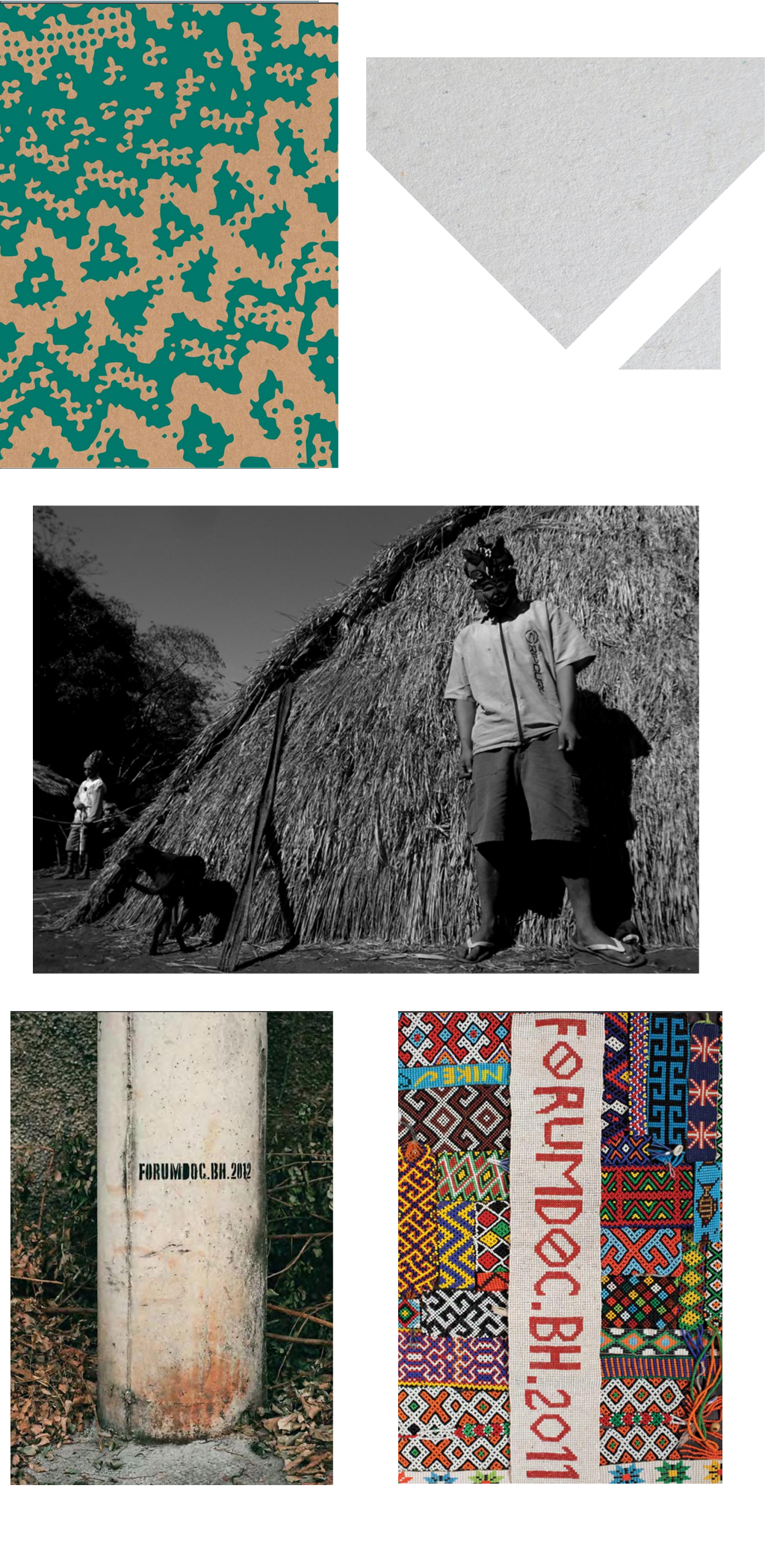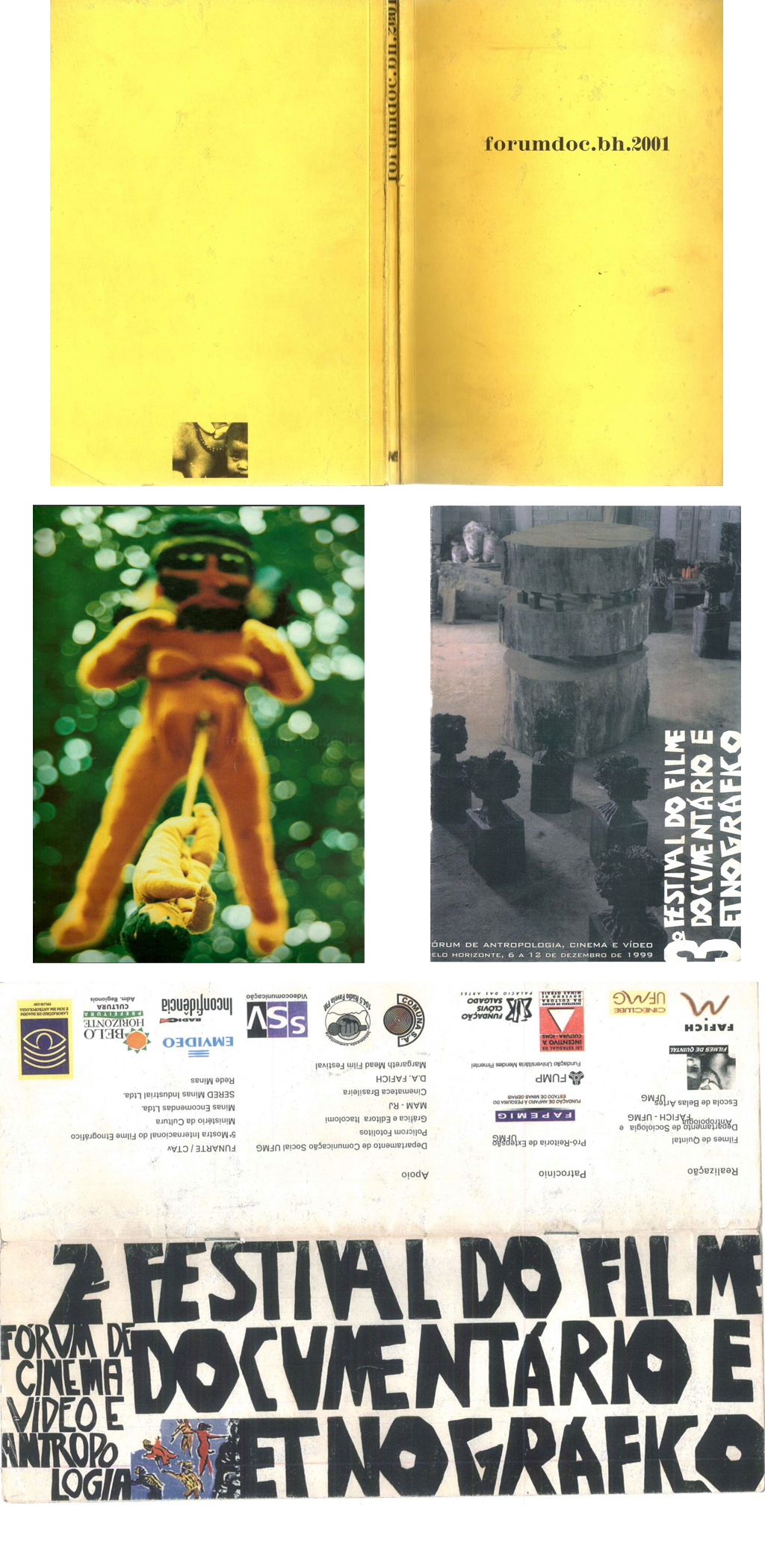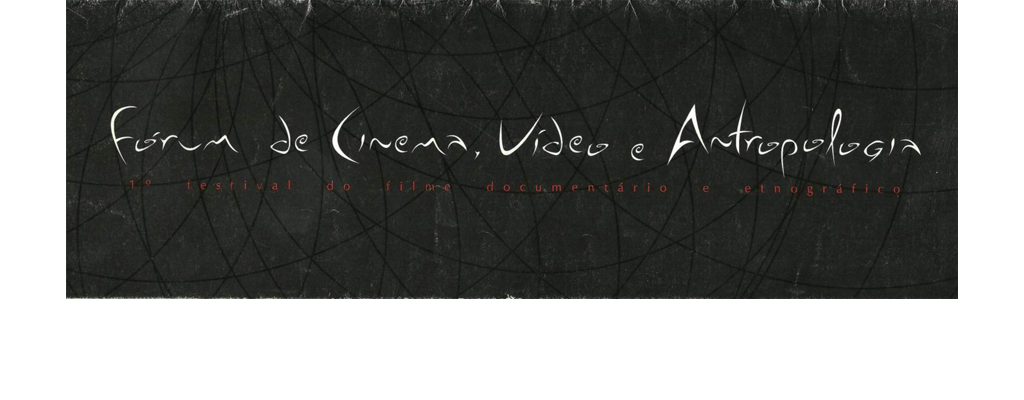Field Notes \ forumdoc.bh
Juliano Gomes and Victor Guimarães with Ewerton Belico and Júnia Torres
Victor Guimarães is a film critic and programmer based in Belo Horizonte, Brazil. He writes regularly for Revista Cinética (Brazil) and Con los ojos abiertos (Argentina).
Ewerton Belico is a programmer, educator, screenwriter, and director. Since 2005, he has served as a programmer of forumdoc.bh, Belo Horizonte's documentary and ethnographic film festival, and he has participated in the team of programmers of numerous other festivals and exhibitions. He co-directed the feature film Baixo Centro (2018), and the short films A Memória Sitiada da noite (2021) and Vira a volta que faz o nó (2021).
Júnia Torres is founding member of the Filmes de Quintal, which has organized the forumdoc.bh festival for the past twenty-five years. She is a documentary filmmaker and anthropologist, curator, and guest programmer. Her films include Nos Olhos de Mariquinha (co-directed with Cláudia Mesquita, 2008), Aqui Favela, o Rap Representa (co-directed with Rodrigo Siqueira, 2003), and A Glance at the Brazilian Afro-descendant Communities (co-directed with Cida Reis, 2007).
Forumdoc.bh emerged in the city of Belo Horizonte in the late 90s. From its inception, the festival’s approach to programming diverged from many of the more prominent festivals in Brazil. Operating in partnership with the Department of Anthropology at the Federal University of Minas Gerais, the festival has focused on forging a bond between experimental media practices in Brazilian and Indigenous nonfiction media production and local public culture in Belo Horizonte. The festival is collectively programmed by a group of individuals who also run the day-to-day logistical operations of the festival, and who sit with the audience for each screening. Its long-standing commitment to creating public space for rich discussion, at the festival with attendees as well as through the critical catalogs the festival publishes each year, contributes to its significant legacy in Brazilian film culture.
Interview
Juliano Gomes and Victor Guimarães
Forumdoc.bh began in Belo Horizonte in the late 90s. What was the context in which it started?
Ewerton Belico
The festival was part of the enormous cultural vivacity of Belo Horizonte (BH) in those years immediately after the administration of Patrus Ananias—a mayor from the Workers’ Party (PT)—which would give rise to a wide range of events. There was the Festival de Arte Negra – FAN (Black Arts Festival), the Fórum BHZ Vídeo (Belo Horizonte International Video Festival), among many others. It felt like something different was possible here, particularly when we think about showing films.
Júnia Torres
There was an image of Belo Horizonte, and Minas Gerais more broadly, as the place for video art, and the presence of so many young artists on the rise affirmed this. Ruben Caixeta de Queiros, Paulo Maya, and I were anthropology students. We were attracted to cinema, particularly the cinéma vérité tradition of Vertov, Flaherty, and especially Rouch. We were very interested in Rouch’s idea of ciné-trance and how it unfolded not only in documentary, but in the experimentations of Cinema Novo—and in their (sometimes ambivalent) relationship with ethnographic films. For us, those films had a sense of openness to alterity, to a “displacement of the gaze,” as we used to say back then, toward other regimes of visibility (and invisibility). But we did not find such films at local events, which seemed to us to be concentrated on overly self-referential works. As we had little to no access to the films we wanted to see and to support—nor access to the peoples involved in the films, so vital to this relationship between cinema and anthropology that would come to characterize the festival—the only way to access them would be to bring in and share these works ourselves. It was a time in which festivals perhaps made more sense than ever, a time located in another era, before the possibility of online sharing. That’s why we made forumdoc.bh.
JG and VG
Forumdoc’s relationship with the university system has always been quite strong. How did you first approach the interplay between cinema and the university in the design of the festival?
JT
We wouldn’t say there is a relationship with the university system in general, but rather a set of relations refracted by one university in particular, the Federal University of Minas Gerais (UFMG). Around the time of the festival’s inception, Ruben, Paulo, and I were students in the anthropology department at UFMG (Ruben and Paulo are now professors there). Ruben had just arrived from a doctoral program in France, bringing the experience of being a student of Jean Rouch at Paris VIII University. He was also an assiduous spectator of Rouch’s memorable film sessions on Saturday mornings at the Musée de l’Homme, which certainly influenced us a lot in the proposal of our festival. I was in graduate school and Paulo was an undergraduate. We teamed up to create the festival, and by its second edition we invited more people to join us, some friends at the university such as Cláudia Mesquita and César Guimarães, who were studying and teaching social communications. In time, other students from UFMG would compose the collective that organized the festival. This relationship with the university, however, was never a subsidiary one, since forumdoc.bh was always carried out by an independent collective that we formed, Associação Filmes de Quintal. Occasionally, the collective would distance itself from the university. But for the most part there has been something like a reciprocal feeding, in which academic events, such as seminars and colloquia and other projects, are linked to the festival’s activities and screening series.
When the festival was starting out, we had to decide where our priorities stood: either we could go to the side of corporate financing, becoming like festivals that already existed, more of the same; or we could ally ourselves with the university, which was, for us, a place of research and experimentation. Of course, there are also strictly pragmatic reasons to align with the university—it helps us secure (modest) project support and funding to hold seminars, guarantee the presence of some of the festival guests, and print the catalogs, even in times of financial crisis in Brazil. These arrangements have allowed us to carry out an annual edition for twenty-five years, without missing a single year in that span. The university was, for us, the nucleus of creation for forumdoc.bh, and it has helped us maintain the project. More than anything, it has fostered new engagements with people, particularly with young students, whose participation in the festival ensures its continuity and freshness. The festival has taken a particular shape over time, but it also constantly renews itself, largely due to the intellectual curiosity of the younger generations, which continues to inspire us.
JG and VG
Can you comment on how forumdoc.bh has approached its relationship with other festivals and the international circuit over the years? We ask because, in comparison to many other festivals, you seem to move in a rather different direction.
EB
At some point, we had internal discussions about the need to stay up to date on international programming, and we thought we might eventually assign someone to track what was happening in festivals abroad. However, we’ve always been limited in terms of resources to carry out this task. When our financial situation became more difficult, we decided to focus on contemporary Brazilian production. In a way, we did stay updated on international cinema through our programming of retrospectives: Chantal Akerman, Pedro Costa, Sylvain George, Avi Mograbi, among others.
In my view, there are three distinctive traits to forumdoc.bh. One, we are dedicated to documentary (with all that this focus implies regarding approximation to and distance from a more industrial cinema), and yet we have always stayed away from Brazilian television documentary production, which is an important vector for the promotion and international dissemination of mainstream documentary. Two, we have maintained a special interest in ethnographic documentary, which is a relatively rare focus, even on the international scene. Three, we have a long-standing interest in what politically engaged production can look like—something that has varied over time, of course.
JT
Forumdoc.bh has never been obsessed with novelty; it has never sought out, as the center of its programming, the most recent and most celebrated films from festivals around the world, especially from the Global North. Although contemporary international productions have submitted work to us, and sometimes have been invited to participate in festival editions, their inclusion has usually been timed to other occasions. When we have been interested in a single film, the latest work by an auteur to emerge at some festival—remembering here names like Sylvain George, Harun Farocki, even Pedro Costa—we have invited the director to curate a thematic series to situate their new work with other films, or we have organized larger retrospectives of their work. The festival is interested in creating relationships between single works, between different times, as well as in exploring ethnographic issues, including those related to formal strategies or philosophical concepts found in specific oeuvres or directors, such as those mentioned above. To mention some others: Agnès Varda, Trinh T. Minh-ha, Chris Marker, Martin Maden, Indigenous filmmakers of Melanesia, and Indigenous cinema made in Bolivia, in Mexico, and among the Inuit. Perhaps we are one of the few festivals where annual programs are chosen through a kind of assembly, where the proposals are presented by members of the collective and we literally vote, and the programs with the greatest number of supporters are chosen. This is still being done, year after year. Not without conflicts, of course.
Excerpt from NŨHŨ YÃG MŨ YÕG HÃM: THIS LAND IS OUR LAND! (Sueli Maxakali, Isael Maxakali, Carolina Canguçu, Roberto Romero, 2020).
JG and VG
Throughout its history, the festival has played a double role in shaping a repertoire. On the one hand, it has articulated documentary traditions from different times and places in the world—for example, in major retrospectives of North American direct cinema, in the Melanesian series, and in such programs as The Enemy and the Camera, The Woman and the Camera, and Queer and the Camera. On the other hand, the festival has revisited the history of Brazilian cinema (including fiction as well, as in the Fernando Coni Campos and Aloysio Raulino retrospectives). This strong, detailed attention to the past is not a priority for most Brazilian festivals. How did you discuss this internally and how did it consolidate itself as a distinctive trait?
EB
The retrospectives of forumdoc.bh started from a particular context—which, in a way, is still our context—of great difficulties in accessing historical cinema, whether Brazilian or international. By this I mean both the obstacles to film conservation and distribution in other countries, with the absence of high-quality copies in circulation (today, we often deal with the circulation of precarious digital files), and the difficulties here at home of accessing international documentary and ethnographic productions, the latter of which are often marginalized in the panorama of releases in Brazil. Furthermore, the festival takes place in a city that is peripheral to the central circulation network of retrospectives and releases. We lack the significant institutions for cinematic exhibition that the major cities have. For example, institutions such as Caixa Cultural and Centro Cultural Banco do Brasil (very important cultural centers with regular programming of historical cinema), which have branches in São Paulo, Rio, and even some smaller cities, are not present here in Belo Horizonte.
JG and VG
The forumdoc.bh catalogs were the first publications produced by a film festival in Brazil to be edited like a reference publication. At the turn of the 2000s, the feeling was that editing those catalogs was as important as—if not more important than—showing films. With the catalogs, it seems the festival pays particular attention to knowledge production and circulation. Has that always been the case?
EB and JT
The catalog texts have been a way to reflect on films as places of thought, and to answer questions posed not only by us, but by other collectives present in the ethnographic and Indigenous films that we love to share. Thinking together with the films is about organizing them, placing them in relationships, proposing curatorial programs to defend them in front of a wider public; it’s also about sharing our curatorial approach, and putting our programs in conversation with the thoughts of other authors.
We would add that the volume and density of these catalogs have varied over time, according to different demands and changes in our programming. For example, in years when our programs focused on Brazilian cinematic (but also political) memory, we published more interviews and archival documents. In other years, when the seminars held around our programming seemed especially robust, there was more theoretical writing. There have been years when the festival abstained from competitive sections, and we published texts dedicated to contemporary productions. Such texts, written by invitation, concentrated on the films selected in the Contemporary Brazilian Showcase (this program spotlights the production of the preceding two years and has always been held at forumdoc.bh), films that in many cases had not yet received critical thinking and writing (and in some cases may never receive this attention, except in our catalogs). These texts emerged as a kind of counter-prize, awarded not to a single work highlighted by a competition jury, but to all the films.
In the early years, the contemporary program was sort of an ugly duckling of the festival and we struggled to attract an audience for those films. Back then it was hard to find formally relevant films in the documentary field to build our programs around. In the decades since, however, we have observed a major transformation in this situation, and our curatorial challenge now is the opposite: we have to deal with an immense range of interesting films, whether by more experienced filmmakers or coming from the most diverse social, geographic, and ethnic and racial backgrounds in the country. Documentary cinema has grown in Brazil and our contemporary program has grown with it, in terms of the number of films, texts, and, above all, interested audiences it attracts. Another important change to our catalogs has been the gradual incorporation of debates and theoretical perspectives over time—for example, the debates around aquilombamentos, queer theory, the questions posed by Indigenous cinema—some of which have influenced the way forumdoc.bh thinks about its own programming.{1}
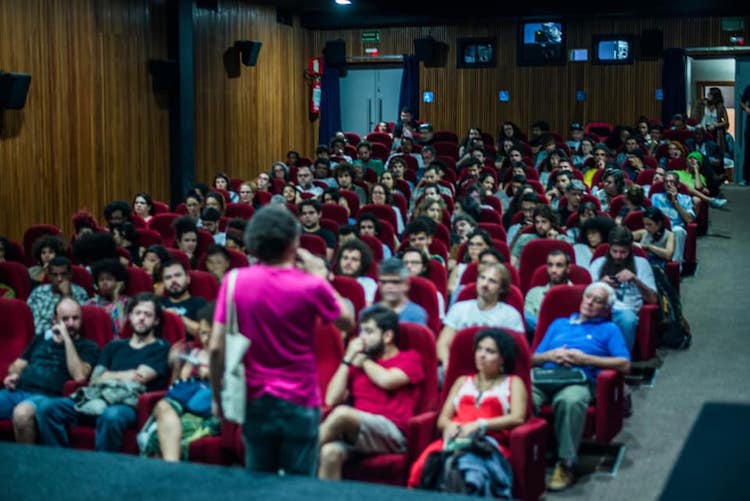 At the 2019 forumdoc.bh, inside the Sala Humberto Mauro. Image courtesy of the festival.
At the 2019 forumdoc.bh, inside the Sala Humberto Mauro. Image courtesy of the festival.
JG and VG
The idea of the forum, which has been in your name from the start, seems to have become one of the festival’s main characteristics: you make space for discussion a central part of the event’s programming, but there is also the presence of lively debate among spectators.
JT
We included forum in our name because we wanted to mobilize encounters, debates, thoughts, and not just to show films. I might add—and perhaps this is more informal and very local—that the debates (some of them heated!) and encounters also invariably continue outside the official space of the movie theater, as in most festivals. But who knows, maybe this is also because we are a smaller and more amateur festival, in the sense that the production and logistics teams are not hired outside the collective. The same people who curate the festival also do the logistical organizing behind it, and watch the films with audiences during it.
JG and VG
Could you say more about funding?
EB
Forumdoc.bh has always been a low-budget festival, with the budget almost always coming from public funds. Even when it was coming from private investment via tax breaks, the festival was still a long way from having substantial resources. This has clearly had an effect on our programming: it has allowed the festival to remain relatively free of pressure from distributors, producers, television broadcasters, or even, in the new scenario that’s emerging, the internationalized, mainstream market of festivals and streaming platforms. This also contributes, of course, to the festival’s relative invisibility on the national and international scene.
Another issue I would emphasize is that, even when there was a greater abundance of resources for moving image production in Brazil, there was a blatant disregard for some aspects of it (diffusion at festivals, conservation, distribution that goes beyond mechanisms of commercial release). It is mostly for this reason that our festival has remained the same size over the last twenty-five years. Adding to this neglect are some more regional characteristics: the difficulty in maintaining long-term public policies to promote culture, the frequent replacement of public financing mechanisms by direct investment in specific projects arbitrarily selected by public officials, and the fact that our state government customarily finances its own actions and cultural institutions through fiscal-incentive laws and tax breaks, which permanently disfigure the local funding mechanisms. So, as Júnia mentioned, UFMG has remained a steadfast ally, filling some of the gaps in an increasingly difficult scenario for promoting culture.
JT
I would reiterate the almost exclusive reliance on public funding in our twenty-five years as a festival. I would also highlight the collaborative efforts of so many people to keep the festival running in times of scarcity. None of us make exactly what we should for the work that goes into creating forumdoc.bh. Considering all the obstacles, this willingness to maintain a project so far outside of market expectations is essential.
JG and VG
How would you describe the festival’s relationship with the area of Belo Horizonte where it takes place?
EB
The festival has always taken place in public spaces, such as Sala Humberto Mauro (the most important state-funded movie theater in Belo Horizonte), and different spaces at UFMG, whether on campus or in its cultural center. Over the years, we’ve managed to increase the scope of the festival beyond the university audience, reaching traditional communities and small towns in the interior of the state, which are often ignored by more typical mechanisms of cultural diffusion. There was another important change in recent years, which was the partnership with Itaú Cultural (a cultural institution funded by a private bank), which allowed the festival to take place regularly outside Minas Gerais, in São Paulo, for the first time. Even if it was only for specific screenings, this development was not insignificant. In addition, I think the migration to online screening during the pandemic expanded the festival’s radius of action, not necessarily to bring in a new type of audience, but to reach spectators and interlocutors that would naturally be the festival’s audience, if they had been in Belo Horizonte. Our online festival was a kind of forumdoc.br, otherwise impossible under different conditions.
JG and VG
The curatorial thinking of forumdoc.bh has always had a unique profile within the Brazilian context . . .
EB and JT
Not infrequently, the historical trajectories of Brazilian filmmakers were hybrid, moving between fiction and documentary, with an important migration of procedures and problems from one type of production to the other. Taking this hybridity into account, forumdoc.bh has participated in several important initiatives to renew the way of seeing the history of Brazilian cinema, especially the films created after Cinema Novo. This is one of the best features of the programming of Brazilian cinema in the last decade and a half—the recovery of films and directors that were out of circulation for many years because they didn’t fit into clear camps. Using the example of Rouch’s films—made collaboratively with peoples, where no hard lines are drawn between the lived and the narrated, between history and cosmology—our project has always sought to present and speak about this fluidity between genres, to view the dissolution of boundaries in positive terms, to pose it as a question in our programming.
JG and VG
And how did Indigenous cinema come to occupy such a central place in your programming?
EB
For a long time, the presence of Indigenous productions at the festival mostly had to do with Vídeo nas Aldeias (VNA), given that so much of the Indigenous production in Brazil was directly or indirectly related to the formative actions of VNA.{2} Why did this work receive such weak support from other Brazilian festivals? I think we can propose a few hypotheses: the historical prejudice against Indigenous populations; the aftermath of the retomada in the 1990s, with all that it did to stigmatize Brazilian moving image production, especially in relation to filmmaking that was more engaged and linked to social and political movements; a wider misdiagnosis of VNA’s output, which many dismissed as a continuation of an outdated aesthetic-political configuration—VNA as a kind of revival of community video—but which in fact hinted at the emergence of a new type of filmmaking (and, by the way, I disagree with the negative evaluation of community video!).{3}
JT
Yes, Vídeo nas Aldeias was there from the first edition of forumdoc.bh. In the second edition, we presented a VNA retrospective with the attendance of Vincent Carelli, Dominique Gallois, and peoples and filmmakers of the Asháninka and Huni Kuin (from the state of Acre, in northwestern Brazil). We have also hosted Wewito Piyãko (with his film Shomõtsi, from 2001) and Zezinho Yube, along with Tadeu and Isaka Huni. Another year the Ikpeng came, from Xingu (a large national park home to several Indigenous nations, in west-central Brazil).
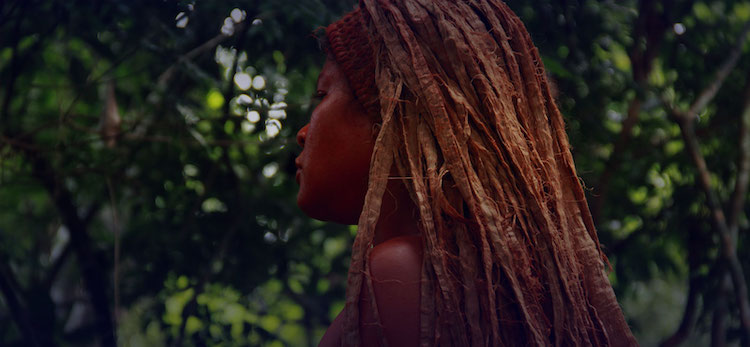 KAAPORA (Olinda Yawar Tupinambá, 2021).
KAAPORA (Olinda Yawar Tupinambá, 2021).
Who knows, maybe we can describe as video art this profusion of recent works that deal with the relationship between image and cosmology. Take, for example, a film we showed two years ago at forumdoc.bh, Yvy Pyte – Coração da Terra (2020), the most recent work by Genito Gomes Kaiowá (a leader of the Indigenous territory Tekoha Guayviri in the state of Mato Grosso do Sul, and one of the directors of Ava Yvy Vera – Terra do Povo do Raio, a film from 2016). Or take Olinda Yawar Tupinambá’s new work, Kaapora, O Chamado das Matas (2020), a filmed performance of the director’s transformation into a caipora (from the Tupi language referring to an “inhabitant of the forest”). But we sense that it’s reductive to put such experiments in the same category as video art. These films, it seems to me, are inventions of another order altogether, and they establish, or are mediators of, quite radical relations of alterity.
JG and VG
Is the recent international success of Nũhũ Yãg Mũ Yõg Hãm: This Land Is Our Land! (Sueli Maxakali, Isael Maxakali, Carolina Canguçu, Roberto Romero, 2020), which had its premiere at forumdoc.bh, symptomatic of something larger?
EB
I think festivals are reacting to a more than justified pushback against decades of indifference to Indigenous moving images. Whether this is going to foster some kind of curatorial shift toward thinking deeply about the originality and diversity of Indigenous cinema from Brazil, without depending on confirmation from international circulation sites (which seem to have finally awakened to Amerindian production), we’ll have to wait to find out.
JT
Yes, I think it is symptomatic: it must be the absolute downfall of Western, white civilization that made international festivals notice Indigenous production after twenty-five years. And it’s taken an equally long time for Brazilian documentary institutions, and for Brazilian cinema at large, to really pay attention to Indigenous cinema here. This is a very recent development. We’ll see where it leads.
This interview was conducted in Portuguese, and translated into English by Victor Guimarães.
Title Video: Trailer for the 2013 edition of forumdoc.bh.
{1} The term aquilombamento refers to the history of the quilombos, the villages established by enslaved Africans in Brazil who escaped from plantations and created their own independent societies. Today, this term is being revisited by Black people in Brazil as a name for contemporary resistance, as well as a method for artistic and political organization.
{2} Vídeo nas Aldeias (Video in the Villages) is an ongoing project initiated in 1985 by filmmakers Vincent Carelli and Virginia Valadão. The idea was to use audiovisual technologies in partnership with Indigenous peoples as a tool of empowerment in these peoples’ fight to preserve their lands and ways of life. The project has generated hundreds of films in various Indigenous communities across Brazil.
{3} Retomada was a slogan created to name the “revival” of Brazilian cinema around 1995, after four or five years of little to no film production in Brazil, owing to the extinction of national funding institutions under the government of President Fernando Collor de Mello. The films of retomada were largely produced through private investment via tax breaks, were aimed at an international market, and were aesthetically associated with mainstream trends in Hollywood and in European festivals. This kind of robust, market-oriented cinema dominated the Brazilian moving image scene for several years, resulting in a lack of visibility for a lot of minor initiatives, mostly in video, across the country.



